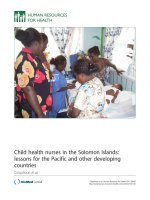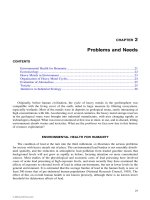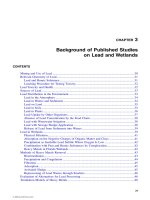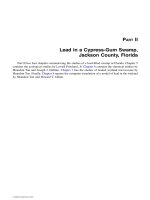Heavy Metals in the Environment: Using Wetlands for Their Removal - Chapter 12 doc
Bạn đang xem bản rút gọn của tài liệu. Xem và tải ngay bản đầy đủ của tài liệu tại đây (350.91 KB, 8 trang )
P
ART
IV
Value and Policy
Based on field and laboratory work on leaded swamps and extensive new literature on heavy
metals, Part IV evaluates wetlands for heavy metal filtration, the state of relevant environmental
laws, and suggested policies. Chapter 11 by Lowell Pritchard, Jr. compares economic and
EMERGY
evaluation of the Steele City Swamp in Florida. Chapter 12 by Wlodzimierz Wójcik evaluates
wetland lead filtration in Poland. Chapter 13 by Jay D. Patel reviews the history of environmental
law in the U.S. relevant to lead and wetlands. Finally, Chapter 14 summarizes, with suggestions
for policy on the industrial ecology of lead.
L1401-frame-P4 Page 143 Monday, April 10, 2000 10:09 AM
© 2000 by CRC Press LLC
145
CHAPTER
12
Emergy Evaluation of Treatment
Alternatives in Poland
Wlodzimierz Wójcik, Slawomir Leszczynski, and Howard T. Odum
CONTENTS
Methods 145
Emergy Evaluation of Wetland Treatment 146
Wastewater Contributions 147
Money Flows for Costs and Investments 149
Flows through Main System Compartments 149
Value of Products 149
Emergy Evaluation of Conventional Treatment 149
Comparison of Emergy Flows of Wetland and Technological Treatment 149
Two options for treatment of mine wastewater were compared with emergy evaluations. The
first option is a conventional physicochemical method with coagulation and filtration proposed
by a Swedish company. The second option utilizes the natural filtration capacity of the Biala
River wetland.
METHODS
Real wealth requirements and contributions of treatment were evaluated by estimating flows
and storages of emergy in inputs and outputs from the treatment systems as explained briefly in
Chapter 2 and applied in Chapter 11. Energy systems diagrams were prepared to identify the most
important flows (Figures 12.1 and 12.2). Then an emergy analysis table was prepared with each
of the important items as a line item. Data expressed in energy, mass, and money units were
multiplied by emergy per unit to obtain emergy flow values. Emergy/money ratio was obtained
from an emergy analysis of Poland (Appendix A12).
Treatments are best that use less emergy resources from the economy while diverting more
emergy of toxic waste from harmful impact and converting more waste emergy into useful or
potentially useful products or storages.
L1401-frame-C12 Page 145 Monday, April 10, 2000 10:13 AM
© 2000 by CRC Press LLC
146 HEAVY METALS IN THE ENVIRONMENT: USING WETLANDS FOR THEIR REMOVAL
EMERGY EVALUATION OF WETLAND TREATMENT
Using information obtained from the Biala River wetland studies (Chapter 9), an ecological
engineering design for the most efficient wetland treatment of heavy metal wastes was prepared.
To improve the processing, a reconstruction of the wetland was proposed to change the hydraulics
of the water flow. For this purpose several dikes and barriers could be built across the wetland as
explained in Chapter 9 (Figures 9.18 and 9.19). Moreover, additional planting of the marshy
vegetation might accelerate the self-organization of the vegetation to the new condition.
The analysis was started by preparing a diagram with all external sources of energy, components,
and connections describing the flows of mass and energy (Figure 12.1). This phase of research
helped us understand how the system is functioning and what the connections are between the
system components. The interior of the systems diagram was simplified to include a water flow
unit, a biomass production unit, and a tank or deposit of organic sediments.
The summary diagram includes the inflows from external sources into the treatment system for
emergy evaluation (Table 12.1). Environmental contributions were those of the land and sunlight.
The rain was small relative to the wastewater inflow and not evaluated.
Figure 12.1
Emergy diagram of natural treatment by the wetlands on the Biala River.
Wastewaters
Mine
x 10
19
sej/25 years
Operating
Services
Services
for Set Up
Water
Lead
Zinc
Nutr.
Sun
Water Flows
Biomass
Zinc
0.005
0.069
0.94
Biomass carrying heavy metals
Particles
Chemical
Binding
Organic
Sediment
Zinc
Lead
Lead
L1401-frame-C12 Page 146 Monday, April 10, 2000 10:13 AM
© 2000 by CRC Press LLC
EMERGY EVALUATION OF TREATMENT ALTERNATIVES IN POLAND 147
Energy of solar radiation reaching the surface was calculated with a function representing
changes with season:
f(t-time) = a + b
*
(sin(t/c))2
*
1000
*
3600
This function was worked out based on data collected by Olecki (1991) using the EUREKA
computer program. Coefficients were as follows: a = 7.3274, b = 107.8975, c = –4.2201.
Wastewater Contributions
Wastewater inflow in cubic meters per second was described by a function expressed by
the equation
f(t) = a + b
ct
where t = time, a = 1.7511, b = 0.9919, c = 0.5098. For the 25-year evaluation the total wastewater
processed was estimated to be 1.7 E9 m
3
/25 years.
The inflowing waters contained emergy of the water, the nutrients, lead, and zinc transported
together. The waters were partially used by transpiring plants, and this emergy contributed to the
treatment work. The rest of the water flowed out, a contribution to downstream users.
Dilute concentrations of nutrients, lead, and zinc were estimated for the inflow waters to evaluate
their emergy content (Table 12.1). This emergy inflow was mainly retained in the system as biomass
and sedimentary deposits.
Figure 12.2
Values of main flows in the model of wetland treatment in Figure 12.1.
Conventional
Technological
Wastewater
Treatment
x 10
19
sej/25 years
Services for
Operation
Services
for Plant &
Equipment
Electric
Power
Sludge
18.2
9.8
24.1
2.0
Water
Mine
Wastewaters
L1401-frame-C12 Page 147 Monday, April 10, 2000 10:13 AM
© 2000 by CRC Press LLC
148 HEAVY METALS IN THE ENVIRONMENT: USING WETLANDS FOR THEIR REMOVAL
Table 12.1 Emergy Evaluation of Wetland Treatment Flows per 25 Years; Area, 74 Hectares
Note Item
Data (raw)
(units)
Transformity
(sej/unit)
Solar Emergy
(sej)
Environmental contribution
1 Sun, joules 5.402 E16 J 1 sej/J 5.402 E16
2 Land 1.295 E14 3.45 E4 sej/J 4.468 E18
3 Total 4.522 E18
Mine wastewater inflows
4 Water used, joules 8.5 E15 4.8 E4 4.08 E20
5 Nutrient nitrogen, grams 5.1 E9 1.05 E9 5.355 E18
6 Lead (dilute), grams 8.5 E8 3 E8 2.55 E17
7 Zinc (dilute), grams 2.55 E9 6 E8 1.53 E18
8 Total 4.151 E20
Purchased from the economy
9 Setup costs 1.57895 E5 $ 6.0 E12 9.477 E17
10 Operational costs 0.11579 E6 $ 6.0 E12 6.94737 E17
11 Total 1.736 E6 $ 1.645 E18
Products
12 Usable water, joules 8.5 E15 4.8 E4 4.08 E20
13 Organic sediment, grams dry 7.82 E10 0.36 E9 2.817 E19
14 Total 4.362 E20
Notes:
1.
2.161 E15 J/year (Olecki, 1991)
*
25 years = 5.402 E16 J/25 year.
2. Area share of global continental land cycle (Odum, 1996, p. 303).
a
(7.0 E6 sej/m
2
/year)(25 years)(74 E4 m
2
) = 1.295 E14.
3. Sum of items #1 and #2 = 4.522 E18.
4. Water transpired: (1.7 E9 m
3
/25 years)(1 E6 g/m
3
) (5 J/g free energy) = 8.5 E15.
Transformity of stream water (Odum, 1996, p. 309).
5. Nutrients used: (3 g nitrogen/m
3
water)(1.7 E9 m
3
/25 years) = 5.1 E9.
Transformity of dilute nitrogen (Odum, 1996, p. 309).
6. Lead: (0.5 g/m
3
)(1.7 E9 m
3
/25 years) = 8.5 E8 g/25 years.
Transformity of dilute metal — see Chapter 4.
7. Zinc: (1.5 g/m
3
)(1.7 E9 m
3
/25 years) = 2.55 E9 g/25 years.
Transformity of dilute metal — see Chapter 4.
8. Sum of items #4, #5, #6, and #7 = 4.151 E20.
9. 1.5 billion Polish zlotys: 9500 Zl/$ = 1.57895 E5 $/25 years.
10. 44 million Polish zlotys/year: 9500 Zl/$
*
25 years = 1.1579 E5 $.
11. Sum of items #9 and #10 = 1.645 E18.
12. Usable water outflow:
(1.7 E9 m
3
/25 years)(1 E6 g/m
3
) (5 J/g free energy) = 8.5 E15 J.
Transformity of stream water (Odum, 1996, p. 309).
13. Organic deposits including bound lead and zinc:
(846 dry g/m
2
/year)(25 years)(74 E4 m
2
)(5 J/g) = 7.82 E10 g.
b
Lead deposited: (1.034 E3 g lead/m
2
/year)(25 years)(74 E4 m
2
) = 7.65 E8 g.
c
Zinc deposited: (3.274 E3 g zinc/m
2
/year)(25 years)(74 E4 m
2
) = 2.42 E9 g. Transformity
of peat (Odum, 1996, p. 311).
14. Sum of items #12 and #13 = 4.362 E20.
a
The value of land for Biala River wetland calculated as for rapid orogenezic
cycle.
b
(1.7 E9 m
3
/25 years)(0.5 g/m
3
)(0.9)/(74 E4 m
2
) = 1.034 E3 g/m
2
/25 years
→
2.295 E17 sej
c
(1.7 E9 m
3
/25 years)(1.5 g/m
3
)(0.95)/(74 E4 m
2
) = 3.274 E3 g/m
2
/25 years
→
1.452 E18 sej
Σ
1.681 E18 sej
L1401-frame-C12 Page 148 Monday, April 10, 2000 10:13 AM
© 2000 by CRC Press LLC
EMERGY EVALUATION OF TREATMENT ALTERNATIVES IN POLAND 149
Money Flows for Costs and Investments
Investment costs were assumed to be 1.5 billion Polish zlotys (for 1992 year) including: cost
of the land, designing costs, costs of materials and machine work, and labor costs. To define the
emergy corresponding to the costs (services and labor), Polish zlotys were first converted into
dollars at the exchange rate of 9500 Zl/$. Emergy/money ratio = 6.0 E12 sej/$ was applied as
calculated in the analysis of Poland in Appendix A12. Operations costs were assumed to be equal
to 44 million zlotys per year, covering the following costs:
Payment for manual work, 7,200,000 Zl/year
Payment for scientific work, 25,000,000 Zl/year
Machine-hours, 12,000,000 Zl/year
Flows through Main System Compartments
As shown in Figure 12.1, the inflowing waters, nutrients, lead, and zinc are used and processed
by more than one pathway, and the emergy flow of each can be calculated as a proportionate
“splitting” of the input emergy. However, for the purposes of this overview analysis, these details
are not necessary except to determine how much of the input emergy remains stored on site and
how much passes downstream (Table 12.1). Because most of the plants are 1-year plants, it was
assumed that all of the biomass flows to the deposit tank each year.
Value of Products
These two systems generate a valuable flow of usable water. Table 12.1 shows this product to
be a large emergy contribution, which can be compared with the emergy of the costs from the
economy. The value of the contributed water (to the cost) is 4.08 E20 sej, so that when divided by
the emergy/money ratio, we find the contribution in 25 years is 6.777 E7 emdollars.
The other main product is the deposited sediment containing the heavy metals. The emergy
accumulated in this deposit is a measure of the environmental protection achieved and potential
value when some use may be found for these sediments in the future. When 1.681 E18 sej is divided
by the emergy/money ratio, a value of 2.793 E5 emdollars is found.
EMERGY EVALUATION OF CONVENTIONAL TREATMENT
A conventional technological treatment uses sand filtration with sodium sulfide and polymers
as a flocculant. The chemicals are dissolved in special tanks and introduced into pipes that feed to
the filters immediately before the pumps supply wastewater from an equalization reservoir. The
sand filter units are flushed periodically and sludge transported by pumping into sedimentation
tanks. Inputs are evaluated in Table 12.2. Figure 12.2 summarizes the emergy flows.
Total required input of emergy for this method is 3.925 E18 sej/year or 9.813 E19 sej/25 years,
while input of energy for operation is 8.64 E18 sej/year or 2.016 E20 sej/25 years (Table 12.2).
COMPARISON OF EMERGY FLOWS OF WETLAND
AND TECHNOLOGICAL TREATMENT
Where the flows of water are large and similar in both systems, a partial but important analysis
can be made by examining only what has to be purchased from the economy. The system that
requires less for the same task is the best one energetically and economically (Table 12.3).
L1401-frame-C12 Page 149 Monday, April 10, 2000 10:13 AM
© 2000 by CRC Press LLC
150 HEAVY METALS IN THE ENVIRONMENT: USING WETLANDS FOR THEIR REMOVAL
Table 12.2
Emergy Evaluation of Conventional Treatment Method (Flows per 25
Years; Area, 5.0 ha)
Note Item Data (Units) Emergy/Unit
Solar
Emergy
Environmental contribution
1 Land 5.0 ha 6.29 E10 3.145 E15
Mine wastewater inflows
2 Total water, lead, zinc 4.151 E20
Purchased from the economy for setup
3 Hydraulic installation 8.125 E6 $ 6.0 E12 4.875 E14
4 Buildings and roads 1.625 E7 $ 6.0 E12 9.75 E19
5 Cost of land 1.0526 E5 $ 6.0 E12 6.31578 E17
6 Total setup 9.813 E19
Purchased from the economy for operations
7 Electrical energy for 1.1455 E15 J 15.9 E4 1.82134 E20
operation
8 Labor for operation 6.06315 E5 $ 6.0 E12 3.6398 E18
9 Chemicals 2.64677 E6 $ 6.0 E12 1.58806 E19
Total operations 2.016 E20
10 Sludge disposal 4.01786 E7 $ 6.0 E12 2.41071 E20
11 Total operation 4.427 E20
Products
12 Usable water 8.5 E15 4.8 E4 4.08 E20
13 Sludge 2.287 E12 0.5 E9 1.143 E21
14 Retrieved metals 2.04 E9 0.5 E9 1.02 E18
15 Total product 1.552 E21
Notes:
1. (5 E4 m
2
)(6.29 E10 sej/m
2
/year (Odum, 1996, p. 110)(25 years).
2. Item #8 in Table 12.1 = 4.151 E20.
3. Costs of hydraulic installation:
$8.125 million.
4. Building and roads:
$16.25 million.
5. 50,000 m
2
*
20,000 Zl/m
2
: 9500 Zl/$ = 1.05263 E5 $.
6. Total setup = sum of items #3, #4, and #5 = 9.813 E19.
7. Electrical emergy for operation:
4.582 E13 J/year
*
25 years = 1.1455 E15 J/25 years.
8. Labor for operation:
4 persons
*
4.8 million Zl/month
*
12 months: 9500 Zl/$ = 24,252 $/years
24,252 $/year
*
25 years = 6.06315 E5 $/25 years
9. Chemicals:
Sodium sulfide
12,614.4 kg/year
*
5.357 $/kg = 67,577.1 $/year.
67,577.1 $/year
*
25 years = 1.68943 E6 $/25 years.
Polymer
6307 kg/year
*
6.071 $/kg = 38,293.7 $/year.
38,293.7 $/year
*
25 years = 9.5734 E5 $/25 years.
Total chemicals
105,870.8 $/year
*
25 years = 2.64677 E6 $/25 years.
10. Sludge disposal:
1,607,143 $/year
*
25 years = 4.01786 E7 $/25 years.
11. Total operation = sum of items #7, #8, #9, #10 = 4.427 E20.
L1401-frame-C12 Page 150 Monday, April 10, 2000 10:13 AM
© 2000 by CRC Press LLC
EMERGY EVALUATION OF TREATMENT ALTERNATIVES IN POLAND 151
Table 12.4 summarizes the emergy flows for the two treatment methods. The emergy required
for installation of the wetland method is 4.151 E20 sej/25 years, while emergy to establish the
conventional method is 9.813 E19 sej/25 years. Therefore conventional treatment methods would
require 68.5 times more emergy from the economy. This emergy difference was even greater for
operations. Emergy of conventional methods was 600 times higher than that required from the
economy for the wetland treatment method.
The natural method is environmentally compatible. In the calculations several wetland contri-
butions were neglected that would increase emergy values such as the benefits from the small
impoundments created and increases in wildlife.
12. Water output = (1.7 E9 m
3
/25 years)(1 E6 g/m
3
)(5 J/g) = 8.5 E15 J/25 years.
13. Sludge = (7.625 E11 g wet/25 years)(60% dry of wet)(5 J/g) = 2.287 E12.
14. Retrieved metal = 2.04 E9 g/25 years.
15. Total product = sum of items #12, #13, and #14 = 1.552 E21.
Table 12.3 Comparison of Requirements from the Economy for
Wastewater Treatment Methods (25 Years)
Category and Units
Conventional
Method Wetland Method
Emergy evaluation
a
Operation 73.8 million em$ 0.116 million em$
Total
b
90.1 million em$ 0.274 million em$
Economic Costs
Operation 43.4 million $ 0.116 million $
Total
b
67.9 million $ 0.274 million $
a
Emergy values expressed as emdollars:
solar emdollars = (solar emjoules)/(6 E12 sej/$).
b
Total = setup + operation.
Table 12.4 Summary of Emergy Flows for the Two Treatment Methods
Category Units Conventional Wetland
Establishing of
a system sej/25 years 9.813 E19 4.151 E20
For operation only sej/25 years 2.016 E20 6.947 E17
Table 12.2 (continued) Emergy Evaluation of Conventional Treatment Method
(Flows per 25 Years; Area, 5.0 ha)
L1401-frame-C12 Page 151 Monday, April 10, 2000 10:13 AM
© 2000 by CRC Press LLC









